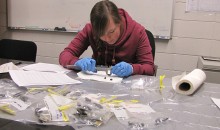Ben Williamson
Kelsey Greenlay with the Caribou Program spent her morning carefully measuring the size of caribou scat—hundreds of pellets about the size of a pencil eraser. Scat is a precious resource in ecology, rich in data that can tell us a lot about the size and health of herds.
During winter, the field crew flies over caribou range in a helicopter, looking for tracks. Follow the tracks and sooner or later we’ll find scat. We bag the samples and bring them back to study.

First we swab the scat for DNA that uniquely identifies individual animals and tells its sex. This is where we bring in our partners. The DNA is analyzed at Wildlife Genetics International.

We get hormones measured at the Toronto Zoo to infer the animals’ stress and health. Then we send samples to the U of C Faculty of Veterinary Medicine and Canadian Wildlife Health Cooperative to be tested for parasites. The last thing to do is for us to get out the calipers and measure the dimensions of each pellet.

And what does the size tell us? It lets us estimate the caribou’s age; older, larger animals have larger droppings. This turns out to be very useful—we can tell which results apply to adults and which apply to juveniles.
Quick example: let’s say hormones in half the female samples are saying the caribou is pregnant. 50% of females of breeding age would be pretty low, but of course a bunch of those samples are probably from caribou that are too young to get pregnant. So we use scat size to see how many of the non-pregnant females are adults, so we can figure out the actual pregnancy rate in the herd.

The data is critical to the “Response of threatened species to linear features and landscape change in a managed forest ecosystem in West Central Alberta” project. We use this fecal data in combination with LiDAR-based terrain metrics to figure out how caribou are responding to a changing forest.
The fecal data is also used by other Caribou Program projects including “Analysis and restoration of seismic cutlines in Southern Mountain and Boreal caribou range in west-central Alberta” and “Assessing disease prevalence and caribou health in west-central and north-western Alberta” project, which is carrying out the first intensive health survey of boreal and southern mountain caribou herds in Alberta.









